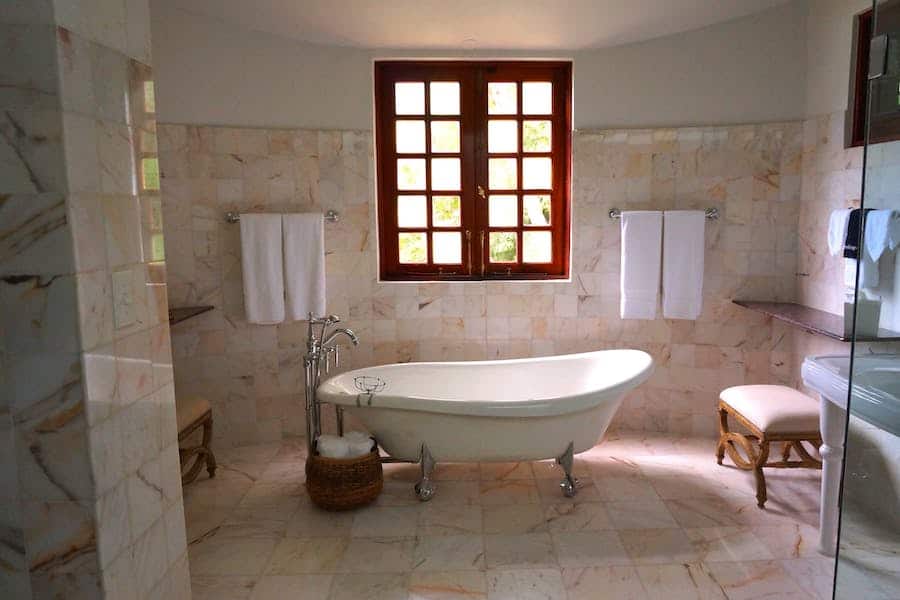The dimensions of a bathtub may seem like a minor detail in the grand scheme of bathroom design, but they can significantly impact your bathing experience. One crucial measurement is the length of the bathtub, as it determines how comfortably you can soak and relax. In this comprehensive guide, we delve into the world of bathtub dimensions, focusing on the question: “How long is a standard bathtub?” We will explore the various types of bathtubs, materials, and factors to consider when selecting the right length for your needs. Whether you’re renovating your bathroom or simply curious about the options available, this article will provide you with valuable insights to make an informed decision.
How Long Is A Standard Bathtub?
A standard bathtub typically measures 60 inches or 5 feet in length. However, there are variations in bathtub lengths, with some reaching 66 inches (5.5 feet) or 72 inches (6 feet). The choice of bathtub length should depend on your bathroom space and personal preferences for comfort and functionality.
Understanding Bathtub Dimensions
Understanding bathtub dimensions is essential when you’re planning a bathroom renovation or selecting a new bathtub for your home. The key dimensions to consider are length, width, and depth, but in this section, we’ll focus primarily on understanding bathtub length.
Bathtub length is a critical factor because it determines how comfortably you can soak and relax during your baths. Standard bathtubs typically come in lengths ranging from 60 inches (5 feet) to 72 inches (6 feet), with 60 inches being the most common size. However, it’s crucial to note that the definition of a “standard” bathtub can vary between regions and manufacturers.
When you consider bathtub length, think about how it fits into your bathroom space and complements your bathing preferences. The right length can enhance your bathing experience, making it more comfortable and enjoyable.
Keep in mind that bathtub dimensions aren’t limited to length alone. The width and depth of the tub also play crucial roles in determining its overall comfort and functionality. To make an informed decision, it’s essential to consider all these dimensions collectively, ensuring that your chosen bathtub suits both your bathroom layout and your bathing needs.
Bathtub Types And Their Lengths
In addition to understanding standard bathtub lengths, it’s essential to be aware of the various bathtub types available in the market, as each type can have different length specifications. Below, we’ll explore different bathtub types and their typical lengths:
Alcove Tubs:
- Length: Alcove tubs are designed to fit within three walls, typically with a length of 60 inches (5 feet). This size makes them ideal for smaller bathrooms or spaces where optimizing the available room is essential.
Drop-In Tubs:
- Length: Drop-in tubs come in various lengths, but a common size is 72 inches (6 feet). These tubs are installed by “dropping” them into a custom-built surround, allowing for flexibility in size and design.
Freestanding Tubs:
- Length: Freestanding tubs are known for their elegance and versatility. Their lengths can vary significantly, ranging from around 60 inches to over 70 inches or more. The length often depends on the style and design of the tub.
Corner Tubs:
- Length: Corner tubs are designed to fit snugly into a bathroom corner, which can limit their length. Common lengths for corner tubs are 60 to 66 inches (5 to 5.5 feet), making them a space-saving option.
Choosing The Right Bathtub Length
Choosing the right bathtub length is a crucial decision when planning your bathroom renovation or selecting a new bathtub. Here are some key considerations to help you make the best choice:
- Assess Your Needs And Preferences: Think about how you typically use your bathtub. Do you enjoy long, relaxing soaks or quick, functional baths? Consider the number of people who will use the tub and their specific requirements. Take note of any height differences among family members or frequent users.
- Measure Your Bathroom Space: Determine the available space in your bathroom where the bathtub will be installed. Ensure that the selected bathtub length fits comfortably within the allocated space without crowding other fixtures.
- Prioritize Comfort And Functionality: Longer bathtubs offer more space for stretching out and enjoying a luxurious soak. Smaller bathrooms may require shorter bathtubs to maximize space efficiency. Consider the depth of the tub in addition to its length for a comfortable bathing experience.
- Think About Mobility And Accessibility: If accessibility is a concern, consider a shorter bathtub with features like built-in handrails or a walk-in design. Longer bathtubs may not be suitable for individuals with limited mobility.
- Budget And Material: Different materials and customizations can affect the cost of the bathtub. Ensure your budget aligns with your desired length and material choices. Remember that while acrylic and fiberglass bathtubs are typically more affordable, they may not be as durable as cast iron or stone.
- Test It Out: If possible, visit a showroom where you can sit in various bathtubs to gauge their comfort and fit. Don’t hesitate to ask for expert advice from showroom staff or contractors.
- Research And Compare: Explore the wide range of bathtub lengths available in the market. Read reviews and gather recommendations from reputable sources to narrow down your options.
- Consider Future Needs: Think long-term. Will your bathtub needs change as your family grows, or will your preferences evolve? By carefully considering these factors and evaluating your specific requirements, you can choose a bathtub length that not only fits your bathroom but also provides the comfort and functionality you desire for a satisfying bathing experience.
Benefits Of Customizing Bathtub Length
Customizing the length of your bathtub can offer several significant benefits, making it an attractive option for those with specific needs or design preferences. Here are some advantages of customizing bathtub length:
Optimal Space Utilization: Custom bathtubs can be tailored to fit perfectly within your bathroom’s available space. This ensures efficient use of the area, especially in bathrooms with unique layouts or space constraints.
Enhanced Comfort: You can adjust the length of a custom bathtub to match your body size and personal comfort preferences. This tailored fit provides a more comfortable and enjoyable bathing experience.
Accessibility: Customization allows you to create bathtubs that are accessible to individuals with mobility challenges or disabilities. Features such as wider entry points, lower thresholds, and built-in seating can be integrated to meet specific accessibility needs.
Unique Design: Custom bathtubs offer endless design possibilities. You can select materials, shapes, and features that align with your bathroom’s overall aesthetic, ensuring a cohesive and visually appealing space.
Personalization: Tailoring the bathtub length allows you to personalize your bathroom. You can create a one-of-a-kind piece that reflects your style and complements the rest of your bathroom decor.
Value Addition: A well-designed custom bathtub can enhance the value of your home. Unique and luxurious features can be attractive to potential buyers if you decide to sell your property in the future.
Luxurious Features: Custom bathtubs often come with the option to include luxurious features such as hydrotherapy jets, LED lighting, or even in-built entertainment systems to elevate your bathing experience.
Long-Term Investment: Since custom bathtubs are made to order and often from high-quality materials, they tend to be durable and long-lasting. This means your investment will provide years of reliable service.
Environmental Considerations: Custom bathtubs can be designed with sustainability in mind. You can choose eco-friendly materials and water-saving features to reduce your environmental footprint.
Resale Appeal: A thoughtfully designed custom bathtub can set your home apart from others on the market, potentially attracting more prospective buyers and increasing the resale value of your property.
Maintenance And Cleaning
Proper maintenance and cleaning are essential to keep your bathtub in pristine condition, regardless of its material or length. Here are some general tips and considerations for maintaining and cleaning your bathtub:
1. General Maintenance:
- Regular Inspection: Periodically check your bathtub for any signs of damage, such as cracks, chips, or leaks. Address issues promptly to prevent them from worsening.
- Clean After Each Use: Rinse the bathtub with warm water and wipe it down after each use to prevent soap scum, mineral deposits, and grime buildup.
- Avoid Heavy Objects: Refrain from placing heavy objects on the edges or within the bathtub, as this can lead to damage over time.
- Use Non-Slip Mats: To prevent slips and falls, consider using non-slip mats or decals inside the bathtub.
- Drain Maintenance: Keep the bathtub drain free of hair and debris to ensure proper drainage and prevent clogs.
2. Cleaning Your Bathtub:
- Materials Matter: Different materials require different cleaning methods. Be sure to follow manufacturer recommendations for your specific bathtub material (e.g., acrylic, porcelain, fiberglass, or stone).
- Avoid Abrasive Cleaners: Stay away from abrasive or harsh cleaning products, as they can damage the bathtub surface. Opt for gentle, non-abrasive cleaners.
- Natural Cleaners: You can create an effective natural cleaner using a mixture of white vinegar and baking soda. This can help dissolve soap scum and mineral deposits. Be sure to rinse thoroughly after cleaning.
- Specialized Cleaners: Some materials may benefit from specialized bathtub cleaners. Always check the label to ensure compatibility with your bathtub type.
- Soft Brushes Or Sponges: Use soft-bristle brushes or sponges to scrub the surface gently. Avoid abrasive scouring pads or brushes that can scratch the bathtub.
- Stain Removal: For tough stains, you may need a slightly abrasive cleaner or a mixture of hydrogen peroxide and cream of tartar. Test a small, inconspicuous area first to ensure it doesn’t damage the surface.
- Prevent Mold And Mildew: Keep the bathroom well-ventilated to prevent mold and mildew growth. If mold appears, clean it promptly using an appropriate cleaner.
Summary
Maintaining and cleaning your bathtub is essential for its longevity and a pleasant bathing experience. Regular inspection, gentle cleaning products, and appropriate tools help prevent damage and ensure cleanliness. Each bathtub material has specific cleaning needs, so adhere to manufacturer guidelines. Preventing mold and mildew growth through proper ventilation and minimizing hard water stains with acid-based or vinegar solutions are key strategies. A consistent cleaning schedule, along with prompt stain removal, helps keep your bathtub in top condition, providing a comfortable and enjoyable bathing space for years to come.
FAQ’s
What Is The Standard Length Of A Bathtub?
A standard bathtub typically measures 60 inches (5 feet) in length.
How Do I Choose The Right Bathtub Size For My Bathroom?
Measure your available space and consider your personal preferences for comfort and functionality.
Can I Customize The Length Of My Bathtub?
Yes, customizing the bathtub length is possible to suit your specific needs and bathroom layout.
What Is The Best Way To Clean A Bathtub?
Use a gentle, non-abrasive cleaner or a natural solution of vinegar and baking soda, depending on the bathtub material.
How Can I Prevent Hard Water Stains In My Bathtub?
Consider a water softener or use a mild acid-based cleaner to prevent and remove hard water stains.




















Leave a Reply